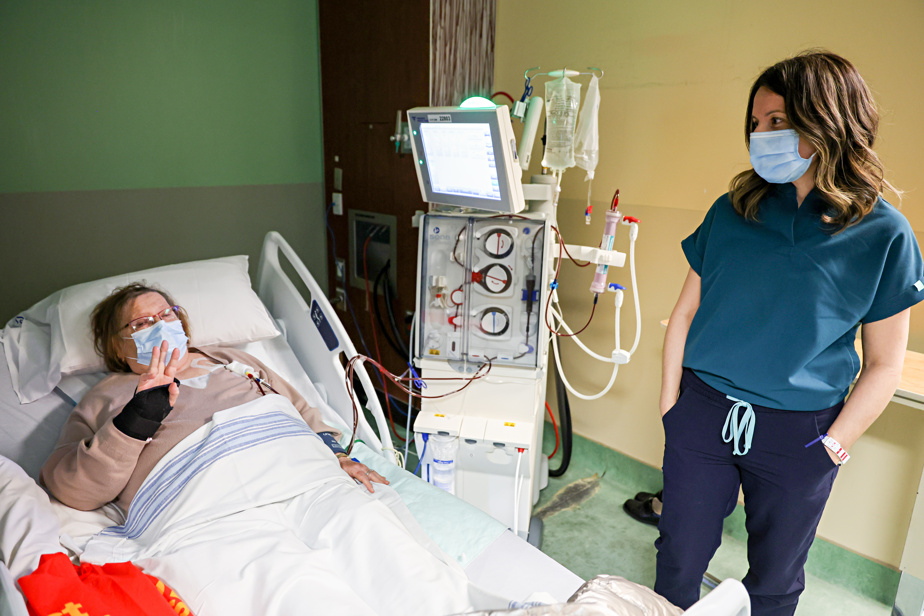Up to 5% of greenhouse gas (GHG) emissions come from the healthcare system. To reduce its carbon footprint, the Laval Integrated Health and Social Services Center (CISSS) has made a detailed estimate, a first in Canada.
Six times less material and 67% fewer IV bags: the numbers speak for themselves, but the sight of disposables is even more so.
Six trays, three bags of solute, various accessories and lots of packaging…
This is what the Cité-de-la-Santé hospital used until recently for the three weekly sessions of hemodialysis – the treatment that purifies the blood when the kidneys fail – for each of its patients. Even well-strung, this disposable material takes up two-thirds of a large table.
Last summer, most of the solutes were removed, replaced by a purified water system. And since this year, the hospital has been placing connectors, similar to small plugs, on the patient’s catheter. With these connectors installed for the week, you no longer need six trays; one is enough.
With these connectors, “the cost of treatment has gone down by about 50%,” calculated Sven Kutschera, Nursing Advisor, Supply. On 20,000 annual treatments, the CISSS will save nearly $45,000. That’s not counting the reduction of more than 20,000 bags of solute in six months. What about reducing GHG emissions?
This is what remains to be measured, indicates the head of the sustainable development committee (CDD) and deputy director of the CISSS technical services department, Benoit Lalonde. “We have a 90,000 ton race. Where will we be this year and how far will we have come? »
These 90,000 tons of carbon dioxide equivalent (t CO2 eq.) represent the annual footprint of the CISSS de Laval. Purchases and staff travel, which fall into a category called “scope 3,” are included in the calculation, a first in the Canadian healthcare system. The CISSS thus discovered that 90% of its emissions fell under scope 3.
“I never thought it would have been so important!” It’s a great realization,” says Mr. Lalonde.
The CISSS now wants to measure the real effect of the actions it is considering and already taking (hemodialysis, planting trees, etc.). “We have more and more ideas, how do we choose? Every dollar we invest, how do we prioritize it? »
It is not the ideas that are lacking.
“We are about 20 doctors who all suffered from eco-anxiety. Getting involved, putting time and energy into finding solutions has been our way of self-treating,” says Dr. Mark-Andrew Stefan, Vice President of the Eco-CPDP, an independent committee formed before the pandemic .
Using less desflurane anesthetic gas (886 kg CO2 eq. per bottle) has notably reduced emissions from the operating room. For many operations, doctors use another less harmful gas, sevoflurane (44 kg CO2 eq. per bottle). They also do general anesthesia with intravenous medication, and many more regional anesthesia, all without gas.
Further reductions are possible, says Dr. Stefan. He gives the example of pumps used by patients with asthma or emphysema. They contain a powerful GHG (hydrofluoroalkane, or HFA), which several medical associations are calling for the removal. Not to mention the roughly 30% of tests, procedures and treatments used in the healthcare system that Canada’s Choosing Wisely Canada campaign says are potentially unnecessary.
Staff travel between home and the workplace generates more than a quarter (26.1%) of CISSS emissions. “I did the math: in terms of CO2 generated, that’s 150 round trips by car from Earth to the Moon. It’s huge,” says Dr. Stefan, who is also responsible for the sustainable mobility subcommittee at CDD.
Telework and even telemedicine, when appropriate, can be put to use. All of Dr. Stefan’s smoking cessation consultations are now done remotely. “Before, patients didn’t show up for appointments. Now we have them on the line, so they don’t fall between two chairs. »
The CISSS is also discussing with the City and the Société de transport de Laval for the development of the cycling network and bus schedules.
“The City is beginning to develop a strategic plan for sustainable mobility. Considering that the CISSS is the largest employer in Laval, we are an almost essential partner,” says Guillaume Charest-Hallée, planning, programming and research officer at the CISSS. A carpooling system is also planned.
“Employees are becoming more and more aware. We have demand, but also a lot of ideas, ”says Mr. Lalonde. “The sustainable development committee is not there to bring all the solutions, but to bring a reflex. If we can imbue that into the culture of the organization, we will have come a long way. »

